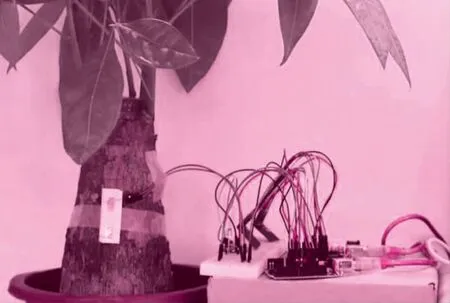四川 孙必慧
山火给世界上一些地区带来了毁灭性的打击。 中国人民大学的化学家王亚培领导的研究人员说,他们已经开发出一种传感器,可以更早地探测到山火。

题材科技 说明文体裁 文章词数 建议用时约3416分钟
难词探意
1. eliminate /ɪ΄lɪmɪneɪt/ v. 消除;排除
2. coordination /kəʊˌɔːdɪ΄neɪʃn/ n. 协调
3. choreograph /΄kɒriəɡrɑːf/ v. 为……设计舞蹈动作;编舞
4. dispatch /dɪ΄spætʃ/ v. 派遣;发送
5. shield /ʃiːld/ n. 盾(牌);保护物;屏障
6. transmitter /træns΄mɪtə(r)/ n. 发射机
Wildfires have recently destroyed regions across the world. Hoping to cut back on harm, researchers led by Yapei Wang, a chemist at Renmin University of China, say they've already developed an advanced sensor to detect such flames earlier.
Most wildfires are reported by the general public,and other alerts come from routine foot patrols and watchtower observers. “Passing planes and satellites also occasionally spot something, but the fire appears on the ground,” Wang says. “When you see the fire from the sky, it's too late.”
The team says its new sensor can be placed near tree trunks' bases and send a wireless signal to a nearby receiver if there's a dramatic temperature increase. That heat also powers the sensor itself, eliminating the need to replace batteries. The team printed the substances onto ordinary paper to create a sensor for just $0.40, as described in June in ACS Applied Materials & Interfaces.

Jessica McCarty, a geographer at Miami University in Ohio, who wasn't involved in the study,says places like San Diego—where wild land and city meet—could potentially benefit from sensors like this. “When a fire breaks out in a canyon that extends to someone's property,” she says, “with such a device, you know that as a homeowner before the fire agency may have detected it.”
But improving coordination among the different agencies involved in firefighting is more essential to address, says Graham Kent, a seismologist (地震 学家) at the University of Nevada, Reno. “The whole way that you respond to a fire until it is put out is like a ballet,” he says. “You'd have to choreograph it just so, with resources allocated at precisely the right time and place from detection to confirmation to dispatch to extinguishing.”
Wang says his team's next steps are to extend the device's signal range beyond the current 100 meters, which can place a restriction on practical use, and to develop a protective shield for it. The effectiveness of the transmitter, McCarty notes, will also need to be tested in the field.
1. What is the second paragraph intended to convey?
A. Some main characteristics of wildfires.
B. The popularity of wildfires around the world.
C. The current regular ways of detecting wildfires.
D. The significance of developing the new sensor.
2. What can we know about the new fire sensor?
A. It is even sensitive to low temperatures.
B. It is relatively less power-consuming.
C. It is inexpensive and self-powered.
D. It works automatically at times.
3. What does the underlined word “that” in paragraph 4 refer to?
A. The new fire sensor. B. The fire agency.
C. The risk of a wildfire. D. The benefit of the sensor.
4. What is the key to fighting wildfires in Kent's opinion?
A. Using technology to detect fire. B. The cooperation between agencies.
C. The good firefighting management. D. Applying technology to putting out fire.
5. What is the disadvantage of the new fire sensor?
A. Its transmitter works ineffectively. B. It still lacks a protective shield.
C. It doesn't send signals far enough. D. It monitors a limited range of areas.
熟词生义
The team says its new sensor can be placed near tree trunks' bases and send a wireless signal to a nearby receiver if there's a dramatic temperature increase.
place v. 放置
e.g. A diamond ring was placed in the birthday cake.



